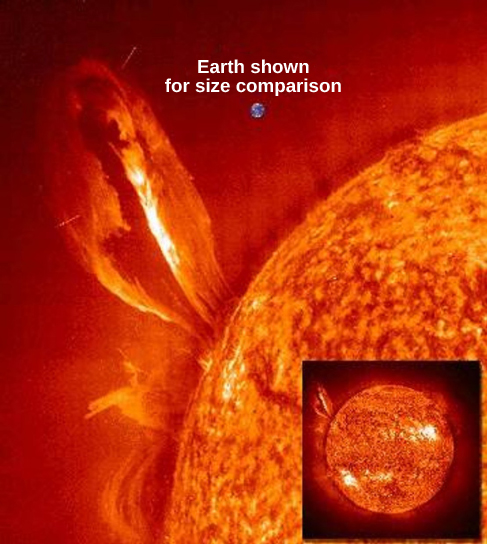10.1 Introduction
The Sun, like all stars, is an enormous ball of extremely hot, largely ionized gas, shining under its own power. And we do mean enormous. The Sun could fit 109 Earths side-by-side across its diameter, and it has enough volume (takes up enough space) to hold about 1.3 million Earths.
The Sun does not have a solid surface or continents like Earth, nor does it have a solid core as shown in Figure 10.1. However, it does have a lot of structure and can be discussed as a series of layers, not unlike an onion. In this section, we describe the huge changes that occur in the Sun’s extensive interior and atmosphere, and the dynamic and violent eruptions that occur daily in its outer layers.
Earth and the Sun

Solar eruption larger than Earth by SOHO/EIT/ESA,ESA Standard License)
Some of the basic characteristics of the Sun are listed in Table 10.1. Although some of the terms in that table may be unfamiliar to you right now, you will get to know them as you read further.
| Characteristic | How Found | Value |
|---|---|---|
| Mean distance | Radar reflection from planets | 1 AU (149,597,892 km) |
| Maximum distance from Earth | 1.521 × 108 km | |
| Minimum distance from Earth | 1.471 × 108 km | |
| Mass | Orbit of Earth | 333,400 Earth masses (1.99 × 1030 kg) |
| Diameter of photosphere | Angular size and distance | 109.3 × Earth diameter (1.39 × 106 km) |
| Mean density | Mass/volume | 1.41 g/cm3
(1400 kg/m3) |
| Gravitational acceleration at photosphere (surface gravity) | GM/R2 | 27.9 × Earth surface gravity = 273 m/s2 |
| Solar constant | Instrument sensitive to radiation at all wavelengths | 1370 W/m2 |
| Luminosity | Solar constant × area of spherical surface 1 AU in radius | 3.8 × 1026 W |
| Spectral class | Spectrum | G2V |
| Effective temperature | Derived from luminosity and radius of the Sun | 5800 K |
| Rotation period at equator | Sunspots and Doppler shift in spectra taken at the edge of the Sun | 24 days 16 hours |
Attribution
“15.1 The Structure and Composition of the Sun – and the connection to the Auroras” from Douglas College Astronomy 1105 by Douglas College Department of Physics and Astronomy, is licensed under a Creative Commons Attribution 4.0 International License, except where otherwise noted. Adapted from Astronomy 2e.

